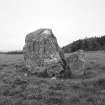Pricing Change
New pricing for orders of material from this site will come into place shortly. Charges for supply of digital images, digitisation on demand, prints and licensing will be altered.
Cairn Riv
Recumbent Stone Circle (Neolithic) - (Bronze Age)(Possible)
Site Name Cairn Riv
Classification Recumbent Stone Circle (Neolithic) - (Bronze Age)(Possible)
Alternative Name(s) Carlin Stone; Cairn Rib; Cairn Riv; Cairn-rieve; Backhill Of Drachlaw
Canmore ID 18323
Site Number NJ64NE 4
NGR NJ 6744 4659
Datum OSGB36 - NGR
Permalink http://canmore.org.uk/site/18323
- Council Aberdeenshire
- Parish Inverkeithny
- Former Region Grampian
- Former District Banff And Buchan
- Former County Banffshire
NJ64NE 4 6744 4659
Not to be confused with possible stone circle (NJ 6709 4630) and stone circle (NJ 6729 4633) at Backhill of Drachlaw, for which see NJ64NE 5 and NJ64NE 6 respectively.
(NJ 6744 4659) Cairn Rib. (NR) (Site of)
Carlin Stone (NR)
OS 6" map, Banffshire, 2nd ed., (1905)
Cairn Riv is said to have been surrounded by a chain of stone circles (of which NJ64NE 5 and NJ64NE 6 and 7 comprise part.)
A portion of a gold chain and a gold ring were found in Cairn Riv. The older spelling of the 'Carlin Stone' was 'Caerlin'.
Name Book 1866.
The Cairn-rieve stone is now the only one that remains of a large cairn which stood partly in Inverkeithny and partly in Turriff. About the year 1820, hundreds of loads of stones were carted from this cairn to build dikes on the farm of Raecloch. At that period the cairn was about 32 yards in diameter. 'In old times a road, about 12 feet broad and edged with slates led from the Cairn-rieve stone to a Druidical Circle at Drachlaw, not far distant - a circle that is still extant.'
J B Pratt 1901.
Cairn Riv. A dotted ring some 95ft in diameter is shown on the Ordnance map and on the S arc is an enormous stone named Carlin Stone. There are 3 stones in line, the Carlin Stone between 2 others quite small in comparison. In addition, there are 2 set stones projecting inwards from the Carlin Stone.
This boulder, rugged, unshapely, and most unusual in height though it be, should be accepted as the Recumbent Stone of a circle that certainly once existed here, and partly because, through the information derived from the tenant of Backhill (Mr Anderson), the following facts were obtained.
In Mr Anderson's father's time, there were several stones, none so huge as the Carlin, 'in a circle,within which was a very low mound or cairn, not a cairn in the true sense, but only 3ft or so in height, spreading over a great space'. The other stones were removed and the mound of stones were carried away for making dikes. In or near the circle were found a small perforated axe-hammer, portions of 3 bronze armlets, flint chips and a jet button.
Mr Anderson gave Coles (1903) the button for presentation to the NMAS.
F R Coles 1903.
'Carlin Stone' (remains of stone circle) Cairn Riv. Inverkeithny.
(Undated) information in NMRS.
The Carlin Stone is 8ft high and 9ft long. There is now nothing to indicate the circle or the 'road' mentioned by Pratt (1901). At the base of the Carlin Stone are a number of stones cleared from the field. No information was obtained regarding the finds associated with the site.
Revised at 1/2500.
Visited by OS (WDJ) 7 September 1964.
As above.
Resurveyed at 1/2500.
Visited by OS (RL) 4 September 1967.
Scheduled as Carlin Stone or Cairn Riv, stone circle, Backhill of Drachlaw.
Information from Historic Scotland, scheduling document dated 9 November 2000.
Measured Survey (2 May 2005)
RCAHMS surveyed the remains of Cairn Riv (the Carlin Stone) recumbent stone circle on 2 May 2005 with plane table and alidade producing a plan of the site and an elevation of the recumbent stone at a scale of 1:100. The plan and elevation were redrawn in ink and used as the basis for an illustration produced in vector graphics software and published at a scale of 1:250 (Welfare 2011, 319).
Field Visit (2 May 2011)
The site of this recumbent stone circle, which formerly enclosed a large cairn, falls near the E corner of a field of improved pasture. Its position is now marked by little more than the large recumbent – the Carlin Stone – standing just off the crest of a minor rise on a long spur dropping down northwards from the Hill of Carlincraig. The circle may have measured in excess of 30m in diameter (Name Book, Banffshire, No. 19, p 29) and the recumbent is shown on the SSW of the pecked outline depicted on the 1st edition of the OS 6-inch map (Aberdeenshire 1872, xxii). The recumbent (2) faces S and is a block measuring some 3.6m in length by 2.6m in height; a support stone is visible beneath its E end. Immediately adjacent on the E an upright stone (A) some 1.2m high is set back from its leading edge; the front of this small stone is turned at an angle to the axis of the recumbent and a small earthfast quartz-rich boulder lies in the gap between them. Although there is no swelling in the surface of the field to mark the position of the internal cairn attested in antiquarian accounts, the soil is stonier to the N of the recumbent than it is to the S.
Visited by RCAHMS (ATW and KHJM) 2 May 2005






![View of the 'Carlin Stone' from south.
Original negative captioned: 'Carlin Stone, Cairn Riv[?] (Cairn now removed) 1900 / View from South'.](http://i.rcahms.gov.uk/canmore/l/SC00680137.jpg)








![RCAHMS survey drawing: Plan, elevation and sections of Cairn Riv [Carlin Stone] stone circle](http://i.rcahms.gov.uk/canmore/l/SC01303193.jpg)








![View of the 'Carlin Stone' from south.
Original negative captioned: 'Carlin Stone, Cairn Riv[?] (Cairn now removed) 1900 / View from South'.](http://i.rcahms.gov.uk/canmore/s/SC00680137.jpg)








![RCAHMS survey drawing: Plan, elevation and sections of Cairn Riv [Carlin Stone] stone circle](http://i.rcahms.gov.uk/canmore/s/SC01303193.jpg)








